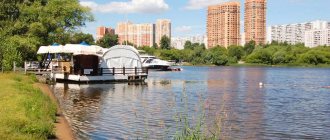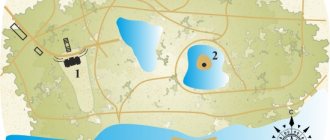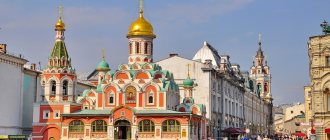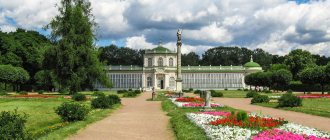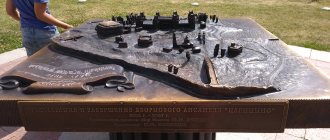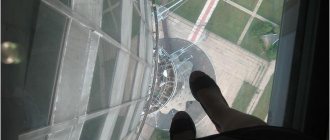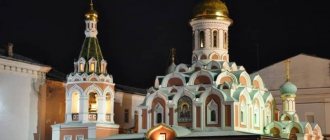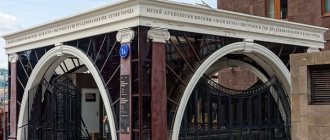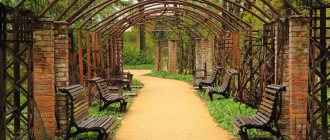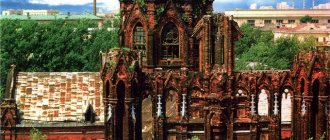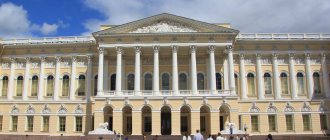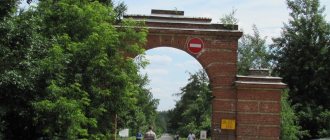After the eighteenth century, many noble estates remained in the Russian hinterlands. Like a European echo of the Age of Enlightenment, each of them is unique and interesting in its own way. They often represent real masterpieces of architecture, which, unfortunately, are now unjustifiably forgotten. The incredibly beautiful building of the former “Vorontsov estate”, located on the picturesque shore of the village of Bykovo, Ramensky district, can rightfully be added to this list.
1. Estate in Bykov, Moscow region
2. Walk around the estate 3. How to get there and get to Bykovo 4. Vladimir Church
Story
This village was first mentioned in the fourteenth century in the will of Russian Prince Dmitry Donskoy, who left this village to his sons Ivan and Vasily before the start of the Battle of Kulikovo. At the beginning of the seventeenth century it was already mentioned as an imperial palace village near the lake.
In the old days, here, on the huge meadows located in the interfluve, there was a point for fattening livestock before sending it to Moscow. It is possible that the village got its name due to this. The tavern that existed in these places before the revolution bore a similar name - “Bull”.
Vorontsov family
In 1704, for great services to Russia, by decree of Peter the Great, the village was transferred to the royal governor Illarion Vorontsov. Historians rarely remember him, but his descendants are better known, as they played a big role in the history of the Russian state.
His eldest son, Mikhail Illarionovich, served as vice-chancellor during the reign of Tsarina Anna Ioanovna. Elizaveta Petrovna appointed him chancellor. He played an important role in the fate of M.V. Lomonosov.
The second son was a governor, but he glorified his family in a very negative way - he took large bribes. The youngest son, Ivan Illarionovich, married Maria Volynskaya.
The great-grandson of the governor, Mikhail Semenovich, bravely commanded a division during the Patriotic War and established himself well as the tsar’s governor in the Novorossiysk region.
The childhood and youth of all the Vorontsov descendants are closely connected with the estate in Bykovo. The last owners of the estate were the Vorontsov-Dashkovs.
MM. Izmailov
In 1762, the Vorontsov estate in Bykovo became the property of M.M. Izmailov. A Turk by origin, in one of the battles he went over to the side of the Russian army and converted to Orthodoxy. For some time he served as the marshal of the royal court. Under Catherine II, he was appointed to the post of chairman of the Expeditions of Kremlin buildings.
Izmailov involved the most famous Russian architect at that time, Bazhenov, in the design and construction of the structure. However, the construction of the palace was soon suspended due to the enormous costs of maintaining the Russian army, which fought with the Turks. Thus, the famous architect was left out of work.
During this difficult time for the great architect, M. M. Izmailov ordered him to work in Bykovo. The estate was noticeably dilapidated and required serious reconstruction. Thanks to this coincidence of circumstances, the talented architect’s finest hour came.
Construction of a new palace
V.I. Bazhenov set to work with desire. We must give him credit, he made a bold decision - to completely change the appearance of the building. According to the architect's plan, the new Vorontsov-Dashkov estate in Bykovo was to be built in the western part of the estate, on an artificial hill. To do this, peasants carried earth in wicker baskets. Three artificial reservoirs were created in the places where the land was selected. Bazhenov’s plans included the creation of a real architectural and park ensemble, consisting of a church, ponds, a winter garden, a park, the Hermitage and a grotto. Unfortunately, the palace built by Bazhenov has not survived to this day.
How to get there
Address:
Moscow region, Ramensky district, village. Bykovo, st. Kolkhoznaya.
Telephone:
(49646) 2-41-26.
Travel by public transport:
from the Kazansky railway station to the Udelnaya station, then buses No. 23, 39 to the Khram (Club) stop.
Next, walk along the narrow passage between the fences, along which you need to exit onto a parallel street, then turn right, walk a little and turn left. The total walk is about 400 m.
How to get to the Vladimir Church by car:
from Moscow along the Ryazanskoe highway to the turn to Bykovo (via Zhilino) - 8 km, then turn left. Next - travel not to the airport, but to the towns of Bykovo and Zhukovsky. Drive right through Bykovo, at the border between Bykovo and Zhukovsky at the traffic lights turn right, then after 200 m turn right again onto the street. Highway, and drive along it to the Vladimir Church.
Vorontsov-Dashkov estate in Bykovo
The palace, which is located in the estate today, was built by an already famous architect at that time, Bernard de Simon, a native of Switzerland, for Count I.I. Vorontsov-Dashkov, its last owner. In those days it was a rare surname. It belonged to E.R. Dashkova, who simultaneously lost her son and husband. In order to preserve the Dashkov surname, Ekaterina Romanovna turned to Alexander the First with a request to assign the surname to her great-nephew by marriage, Ivan Illarionovich. Her request was granted.
Bernard de Simon graduated from the Academy of Arts in St. Petersburg. He built a barnyard, a greenhouse and the main entrance to the estate. These days they are all lost. The entrance ramps and white stone balustrade have been preserved from Bazhenov’s construction.
What is the Vladimir Church famous for?
The Vladimir Church is interesting primarily for its unusual style, which is also called Russian Gothic. It is distinguished by the fact that it looks more like a building from a good fairy tale than like gloomy European temples. And if the latter are decorated with evil gargoyles, then the Vladimir Church shows us the faces of saints.
It is unlikely that you can find something similar in all of Russia. A very impressive building is the Vladimir Church. Bykovo, unfortunately, cannot boast of such beauty today. The fact is that the estate is gradually falling into disrepair, while the temple looks much more well-groomed.
The attractions also include a park that blooms in summer and large ponds.
Palace in Bykovo
Even today, when this building is in very poor condition, it still makes a very strong impression. The palace was built in the traditional style of austere English castles. Its four facades are completely different. The southern one is designed in a classic style. It is decorated with columns in the form of beautiful figures of women.
The walkway, which is located in front of the portico, has a balustrade with railings in the form of exquisitely shaped columns. On the left side of the palace a tower with a sundial was erected.
The northern façade is considered central. It is decorated with a magnificent arch, above which is the coat of arms of the Vorontsov-Dashkov family. The interior decoration of the house was also designed in the English style. Under the ceiling there was a frieze of portraits of the descendants of the Vorontsov-Dashkov family. The hall was decorated with a spiral staircase decorated in Baroque style. In the main hall of the palace, where ceremonial receptions were held, there was an organ made of silver pipes.
In the nineties of the nineteenth century, the Bykovo estate was sold, and according to another version, it was lost in cards to the engineer of the Kazan Railway N.I. Ilyin. The estate belonged to him before the revolution.
Opening hours
Be careful when visiting attractions. From the outside, at any time of the day, you can see what the Vladimir Church (Bykovo) looks like. Opening hours must be checked to enjoy the interior of the temple. Since this is a church, we advise you to dress appropriately, preferably modest clothing and a headscarf for women.
Services are held daily in the Vladimir Church. Every day they start at 9.00, and on holidays they can be added to during the day, evening or night. The exact starting time can be checked on the church website.
If you would like to take part in the service, all you have to do is show up. The Vladimir Church is a place where excursions are not held, it is intended for private visits. However, this will not prevent you from coming here as a group - the number of visitors is not limited.
Bykovo: estate, church
The Temple of the Vladimir Mother of God was erected in Bykovo in 1789. Until now, researchers have not come to a consensus on what project it was built on. Some are sure that this creation belongs to V.I. Bazhenov, others prove that it belongs to A.N. Bokarev or M.F. Kazakov. The magnificent white stone church is made in the Russian Gothic style. It has no analogues in the architecture not only of the Moscow region, but throughout the country. There are two churches in the building - the Nativity of Christ and the Vladimir Icon of the Mother of God.
The main temple is oval, standing on a high crypt. A refectory and two bell towers are attached to it from the west. The structure is crowned by a rotunda with a high spire. It should be noted the luxurious decor of the temple.
The temple looks especially impressive from the western facade, from the location of the bell towers. A snow-white marble grand staircase leads to the main platform, located in front of the main entrance to the upper temple, and the lower temple is located below it.
The interior is decorated with artificial marble and wood carvings.
One of the towers was built as a bell tower with a platform for a bell-ringer, and the other for a clock. In 1884, another bell tower was built, made in the same style, according to the design of I.T. Tamansky.
Walk around the estate
The English park of the Bykov estate cannot help but amaze. The paths that go around the ponds seem to meet and cross each other by chance, then go to the river and again spread like a cobweb throughout the park. The interweaving of paths, the azure surface of ponds and the emerald-blue ribbon of the river cannot but excite the imagination. Once upon a time, the Hermitage, a magnificent French pavilion, was reflected in one of the ponds.
Gazebo and oak tree in the park
There were other architectural uniquenesses that disappeared forever as a result of epochal changes. But those that remain cannot but amaze with the perfection of their forms and proportions, such as the rotunda gazebo. Located on an island, it attracts and excites you with the smell of a distant, irretrievably gone time.
In the middle of the ponds there is a mighty oak tree, it seems to be leaning towards the gazebo and wants to say something to its contemporary. Both the gazebo and the oak tree have something to remember...
Palace and bell tower
The church in Bykovo, the lonely bell tower and the rebuilt palace of the Bykovo estate will not leave you indifferent.
The magnificent palace house, imbued with the spirit of the Renaissance, is even more magnified by the top of the hill on which it stands. The main entrance, like a peacock, spreads its luxurious wings-entrance ramps, measuredly decorated with balustrade lines; the main staircase smoothly descends down to the park, divided by ledges.
Terraces and balconies harmoniously unite the building with the picturesque surrounding landscape, while the main role is played by a huge terrace on the park side made of broken outline stone. Its long and gentle slope with a neglected forest park parting on both sides leads to the river.
The rectangular structure is complicated by projections at the ends and risalits on the sides; one end projection has a superstructure - a tower with chimes. The central part of the palace is marked by a faceted bay window, and the opposite facade is marked by caryatids. The ceiling is decorated with beautiful ornaments. Other parts of the interior, decorated with oak panels and paintings on the walls, have also been preserved.
Temple in the Bykovskaya estate
The two-story Church of the Vladimir Icon of the Mother of God, although not large in size, seems huge and graceful, its spiers and pinnacles piercing the sky.
Fig. 1 Plan of the estate in Bykova
1. Main house.
2. Gazebo.
3. Church.
The sad fate of the estate
A unique complex, the Bykovo estate, the photo of which you see in this article, after nationalization was transferred to an orphanage where Red Army orphans were kept. Gradually, valuable things began to disappear from here - unique paintings, carpets, crystal chandeliers, handmade furniture. Then the organ was broken.
The luxurious pink alley has disappeared, the greenhouse has been destroyed, and the holy spring, where in the old days believers from all over the area went for healing water, is littered.
Gradually, the tenants of the palace began to change more and more often, and the losses from this became more and more noticeable. Eventually the stable disappeared and the Hermitage was dismantled.
After the war, new changes affected Bykovo. The estate was transferred to the fourth department of the Ministry of Health, and a tuberculosis dispensary began operating here. Dormitory buildings, or rather barracks, were built next to the palace.
Currently, the estate is completely abandoned, although some officials talk about sluggish restoration. If the attitude of the authorities towards this unique complex does not change, then very soon not a trace will remain of its former splendor and luxury.
